-
Posts
535 -
Joined
-
Last visited
Content Type
Profiles
Forums
Articles
Gallery
Downloads
Events
Posts posted by Chimaera
-
-
Yeah, Paul. The kiridadhis are great! Easy to make, easy to sharpen, and boy are they useful!
-
-
TP, that is certainly an ROUS!
-
Yes, I suppose you are correct. Been a while since I've read the book. What would the other ROUS's be? Nutrias?
-
Though a capybara is a rodent of unusual size, it is not a ROUS, nor is it a Rodent Of Unusual Size (check the capitalization). Capybaras are actually really cute. In fact, I have a story about capybaras. In the 17th century, Venezuelans loved to eat them. However, one day, they decided- "We should ask the Vatican if we can eat these on lent!" The obvious answer, and the one they received, is no! However, they really liked capybara, so they staged a protest. Eventually, under quasi-duress, the Pope declared that capybaras, who love to swim, are fish, and therefore may be eaten for lent. Same goes for puffins, iguanas, alligators, muskrats, and beavers. Fun fact.
-
Yes, yes. But how is one to cook the ROUS's, who are likely to be the only food source? After all, the flame spouts are most likely methane, which would char the outside but keep raw the inside.
SLAG, ROUS is Rodent Of Unusual Size, a term used to refer to the giant rats inhabiting the fire swamp in The Princess Bride. Not nearly as sweet as the beautiful capybara, as one attacks and savages Wesley's arm almost to the point of killing him. The other itallicized name is that of the deer mouse.
-
BB, makes sense. And yes, he is a good size reference. Just assuming he's Mus musculus or Peromyscus maniculatus or one of their friends, and not an R.O.U.S.
-
BillyBones, what’s the story behind the rodent? I think I’ve seen it in other pics of yours. Just wondering.
-
Twigg, I have removed scale and don’t see anything. I even cut through some copper to make sure. I have a handheld propane torch, but something tells me that that’s not what you meant.
 The elevation problem makes sense. And while it wasn’t quite as easy as a mild steel, it was the easiest HC I’ve done.
The elevation problem makes sense. And while it wasn’t quite as easy as a mild steel, it was the easiest HC I’ve done.
-
A couple days ago I made a chisel from A2 tool steel. Now, I understand the risks of forging an air hardening steel, but they were really friendly and offered me 13' of .5" round for $10, so I couldn't resist. I've heard that it's a beast to forge, as you can't let it start to cool or it'll harden and crack. However, I didn't have any of this happen! I even intentionally tried at a black heat, and it worked poorly but didn't crack or anything. Now, they were 85% sure it was A2, 15% sure it was O1. So, to check this, I heated and let air cool. It skated a file. Not incredibly well, but I also didn't heat it as much as I should've. That sounds like air hardening to me. Has anyone had experience with this steel?? Also, it moved beautifully, almost as well as a 1018 or A36, like it was nothin'.
I'm just so confused!
-
Ah... I do prefer knives. The grinding is relaxing to me, and I've always been fascinated by blades... Especially kiridashis! Just the beauty of going from a piece of round steel to a beautiful, functional little knife! Also, the grinding means that while I do the best I can in the forging, it doesn't need to be perfect.
-
Amazing! Just the sheer amount of steel that needs to be perfectly identical! Some of the most incredible smithing I've seen. Everyone focuses on blades (which can also be gorgeous), but that... Just such a big, intricate piece!
-
We don’t wear shoes in the house so we don’t have issues of that sort (along with not having the plant around here, to the best of my knowledge). I find barefoot or socks cleaner and more comfortable.
-
Yikes! Doesn't sound fun... Though I wouldn't mind some water caltrops... I do love water chestnuts in a good stir fry!
-
Frazer, I certainly agree. That AG in the pic? I can't find it. My workbench is 25 square feet! Nor the crescent wrench for that matter
Though one reason I need to clean it is it's full of steel dust which (with my tendency to wander barefoot) is not always pleasant.
-
Uh Oh! Get a belt burn out or a critical motor failure? Either way not good, but I'm glad you were able to get some done! Remember, the more coins the more layers. Hope you can get some more done. I'm still trying to find a chance to do some (I tried once before with nickels and copper pipe with limited success). I started up the forge, did a couple chisels, a pair of rapid tongs, popped the mokume in the fire... and had to stop. From what I've heard, though, correct heating is the key to success. You want to weld when the coins are starting to look wet. After you're finished with the welds, take your "billet" and throw it at concrete. If it breaks, it means your welds weren't good enough, so you don't waste time trying to make something that's already a failure. After the weld, most people work at a red heat, is my understanding. After you've made a billet, you want to reveal the layers by using a countersink bit to drill part of the way through and then forge out flat. Really hope I can get some made. Not sure what I'd do with it, but it's beautiful material, so I WANT IT! BTW, what size plate did you use, and how thick were your bolts?
-
Yep. Did already.
-
Finally was able to get some good steel and make a real mokume clamp-previous attempt on bottom, new on top. Now I just need to not make a fool of myself and make some!
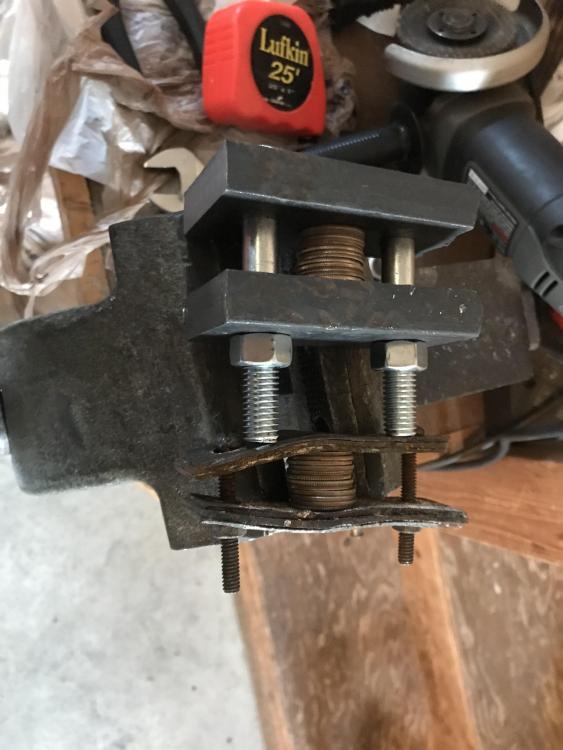
Yes, I know I need to clean my workbench... probably shouldn't have an angle grinder laying there...
After the quarters I might take another try at nickels and pre1982 pennies.
-
BB, I encourage you to do so. However, if you do, you must make sure that you have plenty of pine resin.

Or, even better than a ballista is a polybolos, a repeating ballista. Or you could do a torsion ballista. So many choices, so much destruction!
-
I generally prefer ballistas. A bit more accuracy, a bit less time to contemplate inevitable doom once it fires
-
On 12/19/2020 at 2:33 PM, Frosty said:
No, they have three: one nickel copper sandwiched by two copper nickel outers.
Yes, but, when you fuse the top layer of quarter b to the bottom of a, and the bottom of b to the top of c, you end up with 2n+2*1/2, where n is the number of quarters. Because you will have a half layer at the top of a and a half layer at the bottom of c in our theoretical 3 high stack. If we did a 6 high stack we would have a half top of a, a bottom half of f, then each coin would fuse with its surroundings to make two layers apiece. Then in grinding we would probably take off our half layers and end up with 2*6=12. I’m probably wrong though, As frosty disagrees!
-
Sorry to hear that. It does look excellent, though.
-
6 layers or coins? In theory isn't each coin two layers?
-
True, JHCC, true. However, my hope is that by the time I am, I can make my own tongs from scratch.


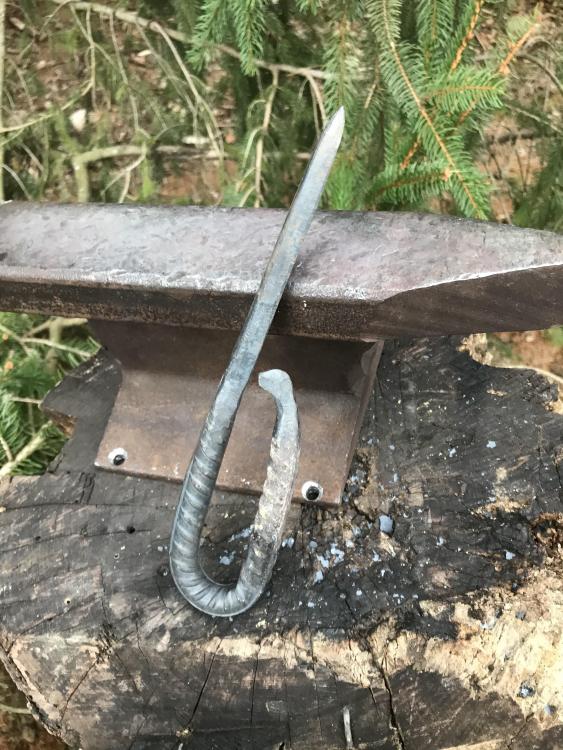
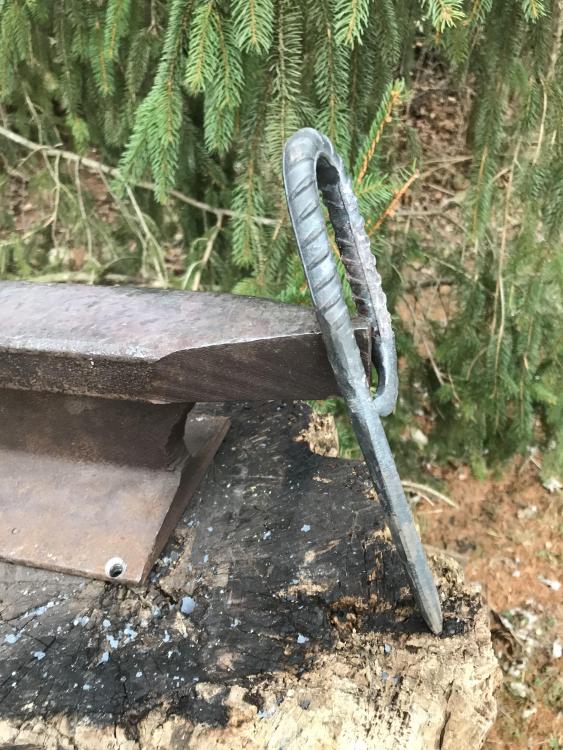
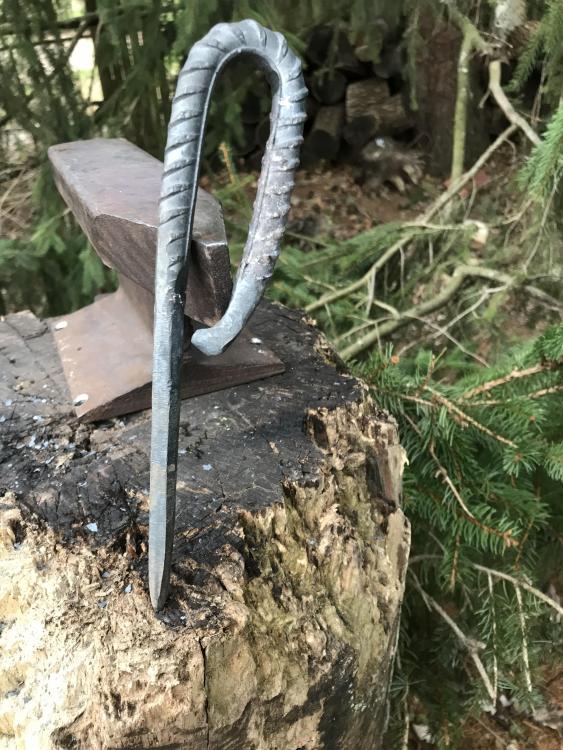
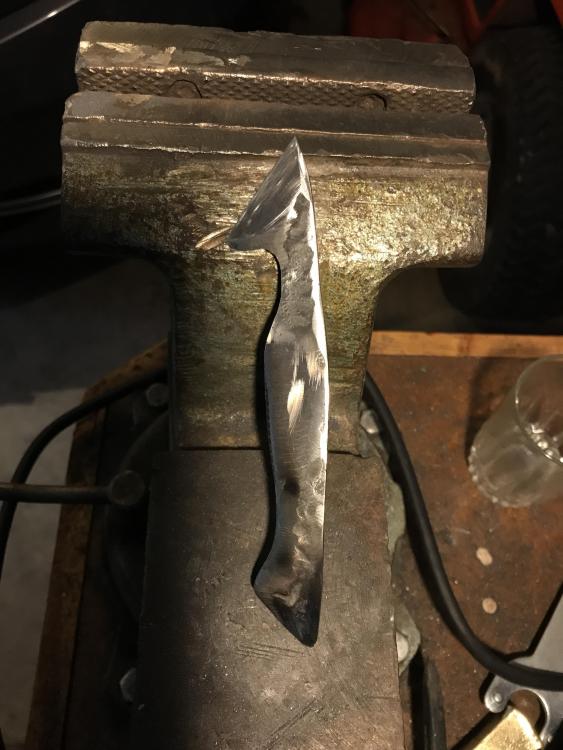
What did you do in the shop today?
in Blacksmithing, General Discussion
Posted
Hondo, on my 4lb I can do at least 4hrs, as that’s the longest I’ve gone. Today my back did go out, for the first time in a while (ever?) though I’m not sure it’s from forging. Update on my kiridashi- through the endless supply of stupidity that the Lord has so graciously supplied me, I hardened the handle. Go figure. That means I can’t drill pin holes, so no handle. Not wanting to go back to the forge, I’m just going to keep this one with a blued steel handle and make one for dear uncle joe another time. Second finished knife